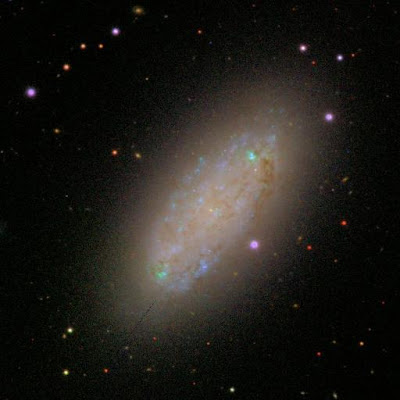Chris wrote:
All I can say is that this is a remarkable skill you have. I know what star colors look like, but I can't construct in my mind what a galaxy made of billions of such stars, all having different colors, is going to actually look like. Of course, I do know what that galaxy looks like with unresolved stars: gray. Add to this glowing ionized gases, which are also gray to the eye, and the situation becomes even more confused.
I can't picture the nebulae. I have never seen the color of nebulae; I have certainly never seen the
red color of nebulae. The best I can do is picture the color I have seen in the Orion Nebula, which I have found to be grey with a very faint tint of green. I'm sure that there is a bit of green in the Orion Nebulae because of the presence of OIII and Hβ emission, both of which are blue-green in color. The green color I thought I could discern in the Orion Nebula was more blue-green than yellow-green, but in any case it was very faint. (When I looked at famous globular cluster M13 through a telescope, I found it to have an unpleasant off-white to yellow-green color, and I have never wanted to look at globular clusters again. Clearly the stars of M13 were too faint for me to detect true color in them.)
I realize that galaxies are made up of mixtures of stars, so I try to take that into account when I picture what a galaxy would look like. To make that easier, I have also looked at nearby or moderately nearby open clusters. Most just look white to me. However, the Pleiades is definitely blue overall, and the Tau Canis Majoris cluster is also slightly blue. Both the Pleiades and the Tau Canis Majoris clusters are truly blue, because all the bright stars in them are blue. As for h and chi Persei, these rich clusters look white to me, but the prominent orange stars in them "jump out at me". For all of that, the overall impression of them is definitely white.
However, h and chi Persei are reddened clusters. The blue stars in them don't have very blue color indexes, due to dust reddening. I do take dust reddening into account when I picture the overall color of galaxies. But I know that in most spiral and starforming galaxies, dust reddening is important only in some parts of the galaxy. In the case of h and chi Persei, much of the reddening is due to the fact that we are situated square in the middle of the galactic plane, and anything that we can see in a spiral arm other than our own is likely to be dust reddened from our vantage point. When I picture a galaxy, I usually picture it so that clusters like h and chi Persei would be less reddened.
I generally picture areas of a galaxy which are dominated by stars of class A, such as our own neighbourhood, as blue. After all, most of the brightest stars that we can see in the sky are stars of class A. The three bright stars of the Summer Triangle are of class A, and five out of seven stars of the Big Dipper are class A. Apart from the class A stars there are also some prominent bright stars of class B and even O. All the bright stars of Orion except Betelgeuse are of class B or O. Large numbers of nearby bright stars of the Scorpius-Sagittarius association are of class B. Prominent open clusters in our neighbourhood are dominated by stars of class A or B: M6, M7, M36, M38, M46, M47 and many others. Certainly there are yellow and yellow-orange stars in our part of the galaxy as well, but these yellow stars are simply outnumbered by the blue stars and don't contribute that much to the overall color of of the stellar light around here. Therefore I think or our galactic neighbourhood as blue, about as blue as, perhaps, the star Altair, which is not impressively but definitely blue to me.
But I also know that most of the light of our galaxy comes from its bulge and nucleus. The bulge, in particular, is particularly yellow, since it almost certainly contains extremely few young stars. This part of our galaxy may not be as yellow as Arcturus, but it will be yellow enough, almost certainly yellower than Pollux. As for the nucleus, there will be a lot of yellow light here too, but the nucleus also contains some very bright young stars which are definitely blue in color.
So it is true that I can't picture the true color of red emission nebulae - or rather, I don't strictly
know what they look like because I have never seen their red color, but apart from that I don't find it extremely difficult to "read" the stellar populations of galaxies if I'm shown good true-color images of these galaxies. And as for the red nebulae, well, I just trust the color images that I'm shown. More exactly I trust the color images of nebulae if I trust the star colors that I can see in the same image.
Ann
 NGC 4911: Spiral Diving into a Dense Cluster
NGC 4911: Spiral Diving into a Dense Cluster